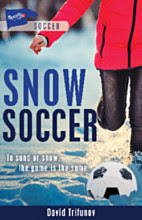| ________________
CM . . .
. Volume XXIV Number 4. . . September 29, 2017
excerpt:
Sarimah is new to Canada and in grade seven in Saskatoon. When the book opens, she is in a camp in Turkey and is playing soccer in the sandy soil. She comes to Canada and notices that the students play soccer in the snow, and Sarimah wants to play, too. She finds her winter clothes cumbersome and awkward to play in, and the ball is frozen and doesn’t bounce the way a soccer ball should. She is having to adjust, not only to a new way of life but to a new way of playing her favourite game. Although set in Saskatoon, Snow Soccer has very little to do with this vibrant city. There is no mention of the South Saskatchewan River, the river valley and the Meewasin Trail which runs for more than 60 kilometres on both sides of the river and is used by people year round. There is no mention of the beautiful Bessborough Hotel which sits majestically on the west bank of the river in the downtown core. It is a 10-storey, castle-like structure – an original Canadian National Railway Chateau-style hotel that awes everyone, including newcomers to the city. There is also no mention of the famous Meewasin Skating Rink which sits beside the Bessborough Hotel. This free facility – ice skates and all - is a drawing card for new Canadians as they try ice skating for the first time. There is no mention of any of the seven bridges which span the South Saskatchewan River, and the school Sarimah attends – Thornton Park School – is an actual school. The school name was Thornton School, built in 1926, and it was one of the famous castle-style schools built in Saskatoon in the early 1900s. The school was torn down in 1997, and condos now grace the spot. Had the story contained some of the interesting and exciting landmarks and features of Saskatoon, the story would have been so much more exciting and would have allowed readers to gain insight to this wonderful city. The story takes place in winter, with very cold temperatures, although there is no mention of the fog that hangs in the air on frozen winter mornings; the hoar frost that often clings thickly to everything, including fence and tree branches; the prickly cold of fingers and toes even when mitts and boots are worn, especially for those who might stand around to watch a winter soccer game; and the icy-fogged breath of anyone out of doors during these temperatures. What is mentioned is the word ‘chinook’. This is a weather phenomena that occurs when warm winds from the Pacific Ocean drift over the mountains in the winter. Chinook is used by one of the characters to explain much warmer Saskatoon weather, but, unfortunately, Saskatoon is too far east of the mountains to enjoy chinooks. Most chinooks take place in southern Alberta, south of Calgary, near Medicine Hat and Lethbridge, but not in Saskatoon. The characters, also, were not realistic and were one-dimensional. Sarimah is in grade seven in the story, although she and the other characters seem a lot younger. Had I not known her grade level, I would have placed her in about grade 4. The story centres around Sarimah’s playing soccer. Whether outside in the snow or inside at a soccer centre, the author does a very good job of describing pages of play-by-play action of the soccer games but spends very little time developing the characters. As well, Sarimah is introduced as a person of the Islamic faith but there is very little which shows this in the book. Describing Sarimah’s culture would have been the perfect opportunity to allow readers a glimpse into the Islamic world through descriptions of dress, food and religious rituals. Although Snow Soccer might be read by readers who are soccer fans, I cannot fully recommend this story because of the lack of landmarks placing the story in Saskatoon; the inaccurate weather conditions; the lack of development of the main character and her Islamic background, and the emphasis of the story on soccer plays, to the detriment of characterization of the story. Recommended with Reservations. Mary Harelkin Bishop is the author of the “Tunnels of Moose Jaw Adventure” series published by Coteau Books. She has also published a biography about Canadian Paralympic Champion Colette Bourgonje, entitled Moving Forward and a picture book version called Gina’s Wheels. Her latest book, Mistasiniy: Buffalo Rubbing Stone (2016) deals with the relationship between a Cree boy and a boy of European descent as they get to know one another and realize the land is important to both of them. Currently she is an Instructional Consultant for Saskatoon Public Schools.
To comment
on this title or this review, send mail to cm@umanitoba.ca.
This Creative Commons license allows you to download the review and share it with others as long
as you credit the CM Association. You cannot change the review in any way or use it commercially. Commercial use is available through a contract with the CM Association. This Creative Commons license allows publishers whose works are being reviewed to download and share said CM reviews provided you credit the CM Association.
Next Review | Table of Contents For This Issue - September 29, 2017 |
